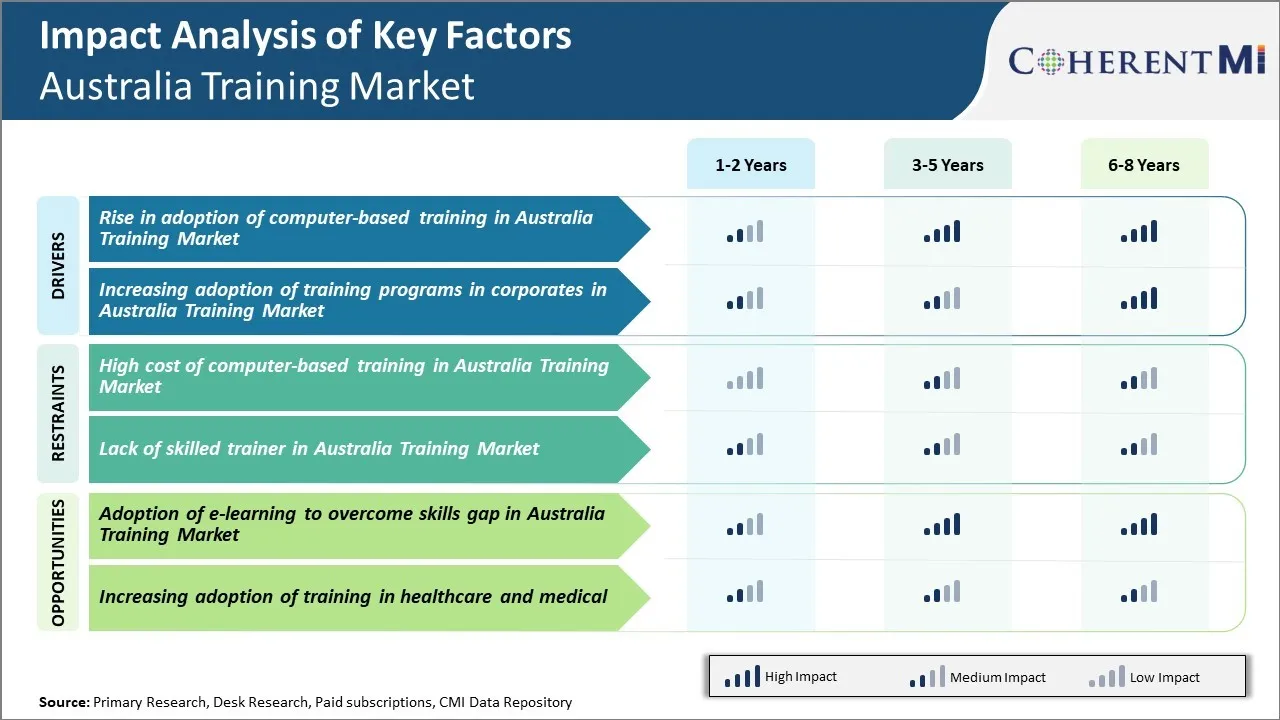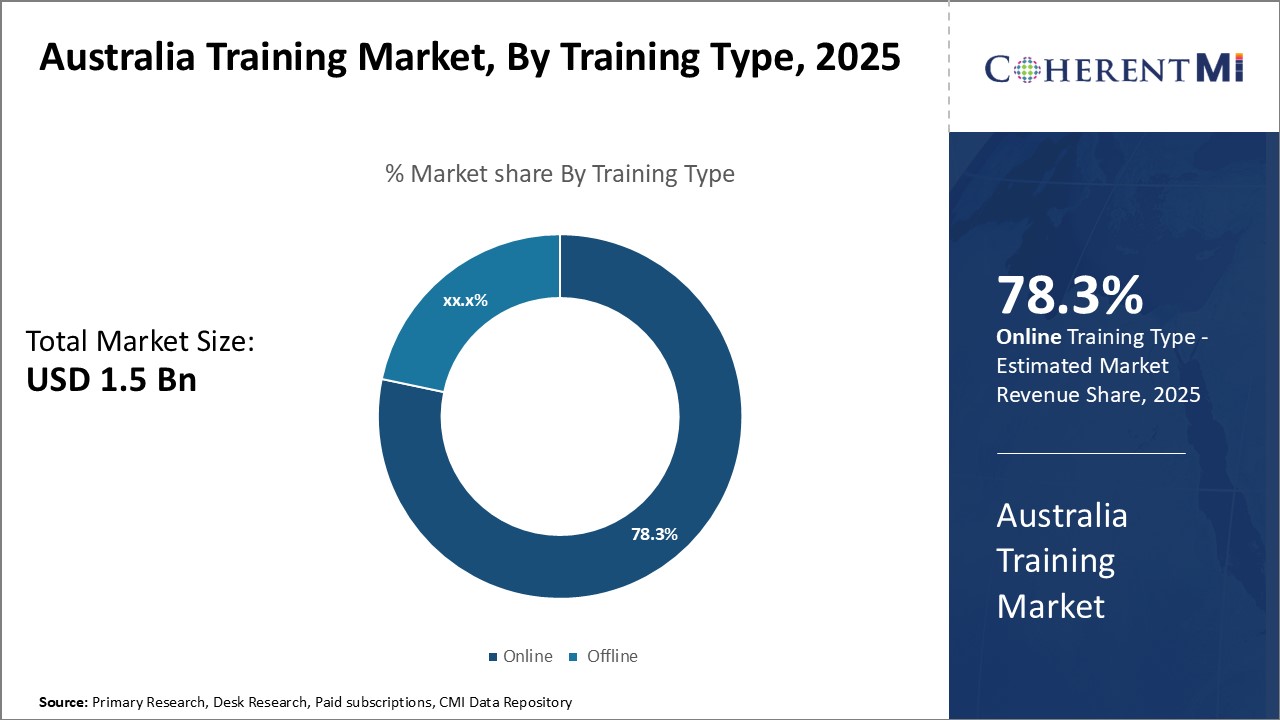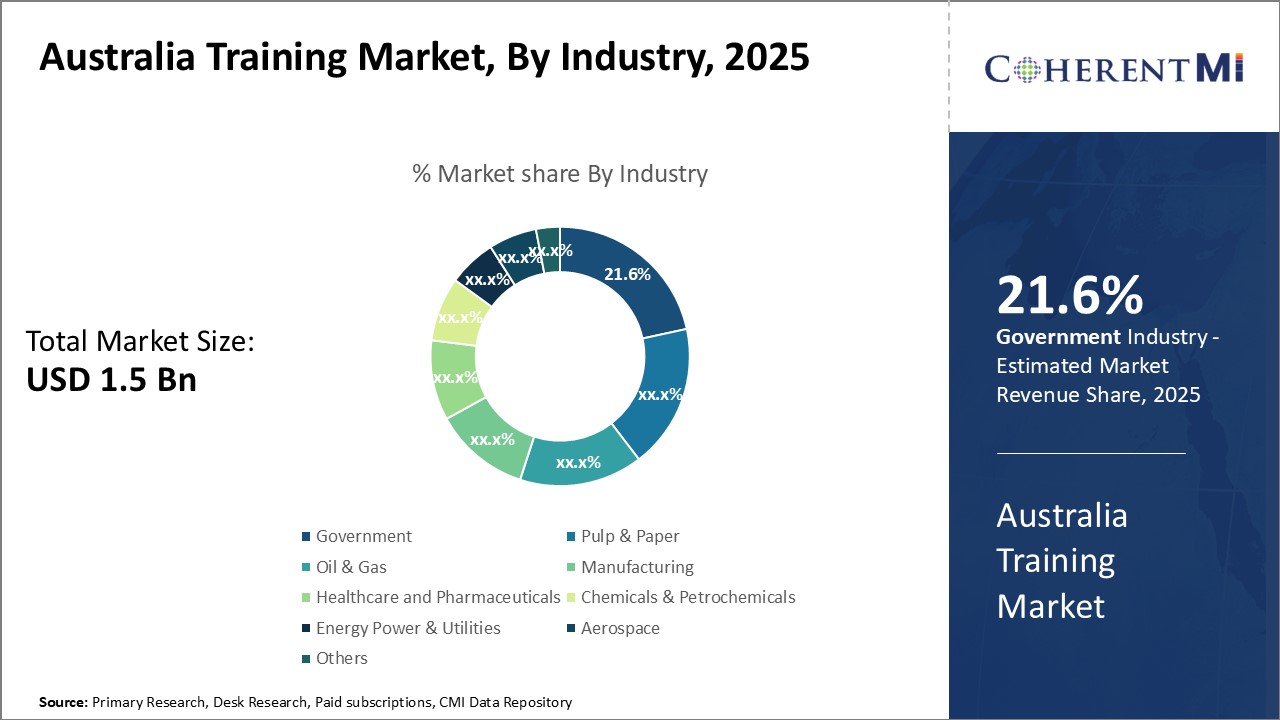Australia Training Market Size - Analysis
The market has been witnessing rapid digital transformation with growing adoption of online and blended learning models. This has pushed many training providers to introduce online learning platforms, immersive technologies like augmented and virtual reality and incorporate adaptive learning and gamification elements in their course offerings. Rising internet and smartphone penetration along with the flexibility and cost benefits of e-learning are some key factors fueling the increased preference for technology driven online training programs.
Market Size in USD Bn
CAGR8.8%
| Study Period | 2025-2032 |
| Base Year of Estimation | 2024 |
| CAGR | 8.8% |
| Market Concentration | Medium |
| Major Players | 360training.com, Inc, Cornerstone on Demand, DuPont Sustainable Solutions, Euro Petroleum Consultants Ltd [EPC], Global Training Solutions, Inc and Among Others |
please let us know !
Australia Training Market Trends
The Australian training landscape has seen a notable shift in recent years towards more technology-enabled and flexible learning options. As businesses and individuals alike have become increasingly tech-savvy, the demand for computer-based and online training solutions has risen sharply.
Government initiatives to boost digital skills and connectivity across Australia have supported this shift. As a result of COVID-19, there has also been accelerated adoption of online tools to support learning continuity during lockdowns and social distancing periods. This rapid change has familiarised Australians with virtual classrooms and e-learning platforms to a degree that was unimaginable just a few years ago.
The rise of computer-based training is set to continue as younger generations enter the workforce already comfortable with digital methods. Its benefits for work-life balance and cost-effectiveness make it a highly appealing proposition for Australian companies and learners in the years to come. While in-person programs still have value in building connections, computer-based training looks primed to dominate the training landscape.
Market Driver – Increasing adoption of training programs in corporates in Australia Training Market
Adoption of formal training programs has grown significantly across Australian corporations of all sizes. Rather than occasional one-off events, a strategic approach involving thorough skills gap analysis and tailored multi-year plans has become the norm. Top firms schedule cohort-based programs throughout the year to maintain momentum, with topic selections informed by frequent workforce surveys and feedback.
Progress has been helped by the realisation that training yields tangible results. Leading firms rigorously evaluate program impact using metrics like productivity gains, error reduction, customer satisfaction scores and recurring evaluation surveys. Return on investment data strengthens the case for ongoing investment at budget planning time each year. As corporate Australia adopts more data-driven methodologies, training will maintain its role as a key performance lever into the future.

One of the major challenges currently being faced by the Australia training market is the high cost of computer-based training programs. Developing effective e-learning courses and content requires a significant investment of time and resources from training providers. Content needs to be developed from scratch and kept up to date with the latest technologies and workforce needs. This involves hiring instructional designers, subject matter experts, multimedia developers and other professionals. Furthermore, there are ongoing costs associated with hosting the content on learning management systems, updating it regularly, and providing technical support to users. All of these factors contribute to the overall high costs of developing and delivering computer-based training programs. This cost challenge makes it difficult for some training providers, especially smaller ones, to offer extensive catalogs of online courses. It also puts pressure on course fees, potentially pricing some individuals and organizations out of the market. Unless costs can be reduced through processes like outsourcing development or leveraging open education resources, high e-learning costs may inhibit the growth and adoption of technology-driven training in Australia.
Market Opportunity – Adoption of E-Learning to Overcome Skills Gap in Australia Training Market
Key winning strategies adopted by key players of Australia Training Market
Workskills, one of the largest private RTOs in Australia, adopted a strategy of focusing on providing customised and niche training programs from 2006 onwards. They identified gaps in the market for specialty skills training and launched programs in areas like crane operation, confined spaces, dogging etc. This helped them attract professionals working in specific industries. By 2010, over 60% of their revenues came from these specialized programs.
Leverage online and blended learning:
Training providers like William Angliss Institute partnered directly with industry bodies and large employers from 2010 onwards to understand their future skills needs and design training programs accordingly. They partnered with industries like hospitality, food processing, logistics to deliver customised and job-relevant training. By 2015, over 50% of their programs were designed and delivered in collaboration with industry partners. This ensured high employability rates of over 90% for their students.
Segmental Analysis of Australia Training Market
 Insights By Training Type - Online dominates the market by owning to increased digitalization and flexibility in learning
Insights By Training Type - Online dominates the market by owning to increased digitalization and flexibility in learningThe online training segment has emerged as the dominant segment in the Australia training market with 78.3% share in 2025 owing to increased adoption of digital technologies across all industries and domains. The digital transformation of education systems has enabled anytime, anywhere access to learning opportunities which has significantly boosted the prospects of online training courses. Learners today prefer the flexibility offered by online programs where they can learn at their own pace and convenience without having to commute to a physical classroom.

Insights By Industry - Manufacturing leading the market due to intensive skill requirements for Industry 4.0 transformation
Moreover, the implementation of advanced technologies like additive manufacturing, cognitive computing, and artificial intelligence is reshaping manufacturing jobs at an unprecedented rate. While some roles will be replaced, new types of high-skilled jobs focused on technology usage, problem-solving, and systems thinking will emerge. Companies are investing heavily in training programs to impart the required technical and soft skills to employees. Sectors like automotive, electronics, and medical devices manufacturing that adopt cutting-edge Industry 4.0 solutions have the greatest training needs currently. The dynamic skill requirements from the manufacturing segment will ensure its dominance in the Australia training industry.
Competitive overview of Australia Training Market
360training.com, Inc, Cornerstone on Demand, DuPont Sustainable Solutions, Euro Petroleum Consultants Ltd [EPC], Global Training Solutions, Inc
Australia Training Market Leaders
- 360training.com, Inc
- Cornerstone on Demand
- DuPont Sustainable Solutions
- Euro Petroleum Consultants Ltd [EPC]
- Global Training Solutions, Inc
Australia Training Market - Competitive Rivalry

Australia Training Market
(Dominated by major players)
(Highly competitive with lots of players.)
Recent Developments in Australia Training Market
- In September 2023, GPStrategies Corp., a global leader in workforce transformation and learning solutions, introduced "Compliance Fundamentals," a comprehensive training solution designed to address critical training needs within organizations. This initiative aims to enhance compliance training by providing a range of off-the-shelf courses focused on financial crime and corporate conduct, thereby supporting compliance, human resources, and learning and development teams.
- In October 2023, Vector Solutions, a leading provider of training and software solutions dedicated to enhancing safety and performance in educational settings, acquired PATHWAYos, a platform that connects K-12 schools and students to work-based learning opportunities. This acquisition allows school districts, states, and career centers to collaborate with businesses, thereby expanding work-based learning programs and bridging the gap between education and workforce readiness.
Australia Training Market Segmentation
- By Training Type
- Online
- Offline
- By Industry
- Government
- Pulp & Paper
- Oil & Gas
- Manufacturing
- Healthcare and Pharmaceuticals
- Chemicals & Petrochemicals
- Energy Power & Utilities
- Aerospace
- Others (Marine, Mining, and others)

Would you like to explore the option of buying individual sections of this report?
Suraj Bhanudas Jagtap is a seasoned Senior Management Consultant with over 7 years of experience. He has served Fortune 500 companies and startups, helping clients with cross broader expansion and market entry access strategies. He has played significant role in offering strategic viewpoints and actionable insights for various client’s projects including demand analysis, and competitive analysis, identifying right channel partner among others.
Frequently Asked Questions :
How big is the Australia Training Market?
The Australia Training Market is estimated to be valued at USD 1.50 in 2025 and is expected to reach USD 2.71 Billion by 2032.
What are the major factors driving the Australia Training Market growth?
The rise in adoption of computer-based training in australia training market and increasing adoption of training programs in corporates in australia training market are the major factor driving the Australia Training Market.
Which is the leading Training Type in the Australia Training Market?
The leading Training Type segment is Online.
Which are the major players operating in the Australia Training Market?
360training.com, Inc, Cornerstone on Demand, DuPont Sustainable Solutions, Euro Petroleum Consultants Ltd [EPC], Global Training Solutions, Inc, GP Strategies Corp., Petroskills, PRYOR Learning Solutions, Raytheon Company, Safety Media are the major players.
What will be the CAGR of the Australia Training Market?
The CAGR of the Australia Training Market is projected to be 8.8% from 2025-2032.